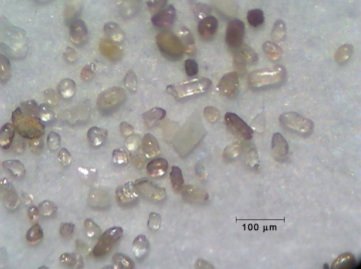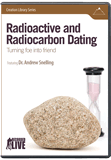
Radioisotopes and the Age of the Earth
Abstract
RATE is an acronym applied to a research project investigating radioisotope dating sponsored by the Institute for Creation Research and the Creation Research Society. It stands for Radioisotopes and the Age of The Earth. This article summarizes the purpose, history, and intermediate findings of the RATE project five years into an eight-year effort. It reports on the latest status of the research on helium diffusion through minerals in granitic rock, accelerated nuclear decay theory, radiohalos, isochron discordance studies, case studies in rock dating, and carbon-14 in deep geologic strata. Each of the RATE scientists will present separate technical papers at the Fifth International Conference on Creationism on the details of this research.
Keywords: radioisotopes, isotopes, age, dating, nuclear decay, accelerated nuclear decay
This paper was originally published in the Proceedings of the Fifth International Conference on Creationism, pp. 337–348 (2003) and is reproduced here with the permission of the Creation Science Fellowship of Pittsburgh (www.csfpittsburgh. org).
Introduction
The conventional scientific view typically expressed today is that the earth is about 4.6 billion years old and the universe between 10 and 20 billion years old. These estimates are based primarily on the abundances of parent and daughter radioisotopes and the implications of stellar and cosmological models. Yet, a literal interpretation of Scripture and much scientific evidence has been gathered to indicate that the creation of the earth, the solar system, and the universe occurred only a few thousand years ago.
One of the principal forces which has traditionally driven estimates of an old age for the earth is the necessity for long periods of time for evolution. Even before radioactivity was discovered in the 1890s, estimates of the age of the earth were growing longer and longer as the complex nature of life became more evident. However, it has never been demonstrated that the evolution of life from inorganic chemicals has occurred or that life has evolved from simple life forms to the complex ones we see today. Living systems, even the simplest ones, are based upon symbolic language structures of extreme complexity. There is no hint in the laws of chemistry and physics that matter on its own can ever generate symbolic language regardless of the time allowed. Because it has no solution to this fundamental difficulty, evolutionary dogma is now facing a major crisis that long periods of time simply cannot mend.
Young-earth creationists on the other hand are not convinced that long periods of time have transpired since the origin of the earth—and some include the origin of the entire universe. In defending a young-earth position, they typically point to important assumptions underlying these dating schemes. For example, when a parent isotope decays into a daughter isotope, the initial concentration of the daughter isotope may affect the estimate of time since the process started. Creationists in some cases question the conventional assumption that the initial amount of daughter product is small or at least can be tightly constrained. Isochron methods attempt to remove this uncertainty, but the results are not wholly satisfactory. Also often questioned by creationists are the assumptions that the quantities of the parent and daughter isotopes have not been altered by non-radioactive processes such as migration and transport, and that the rate of decay from parent to daughter has been constant during the period under consideration. Most researchers attempt to justify each of these three assumptions, but ultimately no one can be certain if the conditions have been met, particularly over long periods of time.
It is hypothesized by the RATE group that at some time in the past much higher rates of radioisotope decay have occurred, leading to the production of large quantities of daughter products in a short period of time. It has been suggested that these increased decay rates may have been associated with the rock-forming processes on the early earth, and possibly one of the results of God’s judgment upon man following creation. The RATE group suspects that large amounts of radioactive decay may have occurred during the first two and a half days of creation as part of the supernatural creation process. The jury is still out and, until we complete our research phase, this thesis remains tentative. The presence of supernatural “process” during creation is essential to our approach, however. Scripture talks of at least two major events which occurred after creation, the Judgment in the Garden of Eden and the Flood. It would seem appropriate to consider at least that an original distribution of elements could have been mixed, and radioactive processes speeded up during one or both of these events.
History of the RATE Project
On July 5, 1997 a group of young-earth creationist researchers met in San Diego, California to address the issue of reconciling radioisotopes and the age of the earth as reported by Vardiman.1 It was recognized by the group that this was a significant problem which must be addressed if young-earth creationism was to continue to have a significant impact on the issue of origins both within and outside the Christian community. The group, which has since become known as RATE, decided that the primary approach would be to explore accelerated rates of decay of radioisotopes during one or more of the Creation, Fall, and Flood events. A second approach would be to address the mixing of mantle and crustal reservoirs since the origin of the earth. Additional processes and issues have been suggested and explored as part of the research. The focus of the RATE research would be primarily on long-age isotopes and their use as chronometers.
By February, 2003 six annual meetings of RATE had been held by the principal investigators. These meetings included reports, discussion, allocation of funds, and research decisions. During the third meeting thirteen research experiments were identified as shown in Tables 1 and 2. A brief description of each experiment, expected results, the estimated cost, and estimated time were developed. At the annual meeting in 2001 the importance to this project of 14C in deeply buried fossil material was identified, and a research thrust on this topic was added. The cost of the eight-year project was estimated to be about $500,000. Before 2002 about 80% of these funds had been raised through private donations. Two major reports were planned for RATE. The first report, a 675-page book was published in December 2000 entitled, Radioisotopes and the Age of the Earth: A Young-Earth Creationist Research Initiative. It contains an introduction to the project, a report on the literature searches by the principal investigators on most of the topics of concern, a glossary, and a set of research proposals. The purpose of the initial report was to stake a claim. It was also published to lend structure and direction to the effort and to inform contributors about what they could expect from their donations. The second and final book is planned to be published in 2005 and is expected to be titled Radioisotopes and the Age of the Earth: A Young-Earth Creationist Research Report. It will report on the findings of the five-year research phase.
Intermediate Results of RATE Research
Helium Diffusion—Dr. D. Russell Humphreys, PI
Two decades ago, it was reported by Gentry, Glish, and McBay2 that up to 58% of the helium (a daughter product of uranium and thorium decay) generated during the alleged 1.5 billion year age of the Precambrian granodiorite beneath the Jemez Mountains near Los Alamos, New Mexico, was still in the zircons embedded in the biotite crystals contained within the granodiorite. Yet, the zircons were so small (see Fig. 1 for a picture of typical zircons) that they should not have retained the helium for even a small fraction of that time. The high retentions suggest to us and many other creationists that the helium has not had time to diffuse out of the zircons—that accelerated nuclear decay produced over a billion years worth of helium only thousands of years ago. Such accelerated decay could reduce the radiometric timescale from gigayears down to months.
A theoretical creationist model, based on observed helium retention, of diffusion rates of helium over a period of 6,000 years was reported by Humphreys3 and Humphreys et al.4). It compares well with laboratory measurements in Jemez zircons, as shown in Fig. 2. The solid dots show the diffusion coefficient as a function of inverse temperature for the measurements with the Jemez zircons and the solid lines through empty squares show the theoretical predictions from the theoretical model. There is a five-order-of-magnitude difference (100,000 ×) between the predictions of diffusion for the evolutionist and creationist models. The measured diffusion rates of He predict that helium would leak out of a zircon/biotite matrix in a period of time on the order of thousands of years, not hundreds of millions of years. This is consistent with the high concentrations of helium still found in the Jemez granodiorite.
Table 1. High priority RATE experiments.
| Experiment | Description | Expected Results | Time |
|---|---|---|---|
| He Diffusion | Determine He diffusion rates through minerals under various conditions | Acquisition of data on which to base a claim that the amount of He in rocks today should not be so high if it was produced by nuclear decay over millions of years. If the He was produced within the most recent thousands of years, it would be expected to remain still in the rocks as observed. | 2 years |
| Isochron Discordance | Construct 5-point mineral and whole-rock isochrons on selected basaltic rocks formed during the Flood | Increased evidence for discordance among isotopic dating methods using isochrons for mineral components of Flood-related rocks. Based on the consistency of the discordance from these specimens and others, infer the processes which led to the distribution of isotopes. | 2 years |
| Nuclear Decay Theory | Conduct a literature search for evidence and models of accelerated nuclear decay and adapt to a creationist worldview, if appropriate. Complete studies on a and b decay. | Increase evidence that nuclear decay can vary radically in response to changes in cosmological “constants” and environmental effects. Associate other likely effects with biblical statements and observational data. | 2 years |
| Radiohalos | Determine the geological distribution of Po halos, their proximity to concentrations of U and the relationship to different halo types. | Resolve the question if Po halos are special evidence for created rocks only , or could they also occur in Flood rocks. This effort may also allow inferences about the process of radioisotope decay and halo formation. | 5 years |
| Fission Tracks | Estimate nuclear decay rates during the Flood using the fission track method. Select an initial sample from a tuff bed in the Muav Formation of Grand Canyon. | Fission track estimates of nuclear decay rates are thought to be absolute following rock formation and do not inherit prior evidence of decay. It is important to know if decay rates were accelerated during the Flood. | 2 years |
Additional laboratory measurements and modeling studies of helium diffusion in zircon are expected to lead to a further refinement of the creationist model. The data of Fig. 2 indicate an age between 4,000 and 14,000 years since the helium began to diffuse from the zircons. This is far short of the 1.5 billion year evolutionist age! We believe that the final results will resoundingly support our hypothesis concerning diffusion and radiogenic helium.
Table 2. Lower priority RATE experiments.
|
Fig. 1. Zircons from the Muav Tuff, Grand Canyon, Arizona (Courtesy of Geotrack International Laboratory). |
Nuclear Decay Theory—Dr. Eugene F. Chaffin, PI
The quantum theory of alpha and beta decay are being reviewed by Chaffin,5,6 with extensions of the standard models being explored to see if they could lead to accelerated decay during episodic variations of the coupling constants. Variations in the radii of compactified extra dimensions and consequent variation in coupling constants over the history of the universe could cause accelerated decay. If, during early Creation Week, say the first 2+ days before the creation of plants, such variations were to occur, they could lead to accelerated nuclear decay, thus adjusting isotopic abundances, without giving unacceptable doses of radiation to life. Part way through day 3, God created grasses, herbs, and fruit trees which could have been damaged by high radiation. Or, during the Fall of Genesis 3, or during the Genesis Flood, smaller variations are possible.
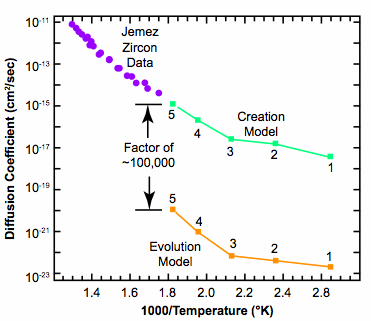
Fig. 2. Plot of diffusion coefficient of He in zircon vs. inverse temperature.

Fig. 3. Plot of nuclear potential energy vs. radial distance from the center of a nucleus.
These variations may help explain the abundances of radioisotopes, including radioactive equilibrium found in decay chains such as the uranium series, within the young-earth time frame. We are also exploring the tunneling theory of alpha decay to see how much change in half-life is possible without drastically affecting other measurable properties of nuclei. For only slight changes in the depth of the nuclear potential well (see Fig. 3), abrupt changes in the number of nodes of the alpha particle wave function occur which can lead to drastic changes in half-life. Also, the half-life depends exponentially on the shape of the potential well, so that even slight changes are effective in accelerating alpha-decay.
Radiohalos—Dr. Andrew A. Snelling, PI
The significance of radiohalos is due to the fact they represent a physical, integral historical record of the decay of radioisotopes in the radiocenters over a period of time as discussed by Snelling7 and Snelling and Armitage.8 The darkening of the minerals surrounding the radiocenters is caused by damage to their crystal structure by alpha particles produced by nuclear decay. As part of a systematic effort to investigate radiohalo occurrences in granitic rocks globally and throughout the geologic record, suitable samples have been collected from the La Posta (southern California), Stone Mountain (near Atlanta, Georgia) and Cooma (southern New South Wales, Australia) plutons.
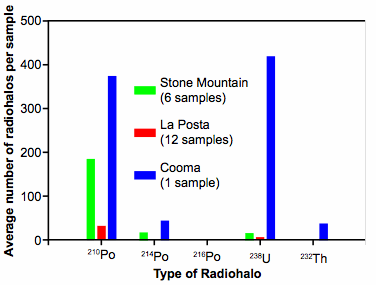
Fig. 4. Number of radiohalos vs. type and location.
The biotite crystals in all these granites contain abundant 238U, 210Po, and 214Po radiohalos. The occurrence ratio is approximately five 210Po radiohalos for every 214Po and 238U radiohalo, which occur roughly in equal numbers except in the Cooma pluton (see Fig. 4). While these radiohalos are homogeneously distributed throughout the mineralogically uniform Stone Mountain pluton, they are almost exclusively concentrated in the muscovite-biotite granodiorite core of the La Posta pluton. Furthermore, there are four to five times more of all these radiohalos in the associated late-stage, Indian Hills granite (southern California).
Hydrothermal fluids are invariably concentrated in the last liquid phases during the rapid convective cooling of granite plutons as discussed by Snelling and Woodmorappe,9 so this pattern of radiohalo occurrence in the La Posta pluton and Indian Hills granite strongly suggests that the Po radiohalos have formed as a result of late hydrothermal fluid transport of Po radioisotopes locally within the biotite flakes separating them from their parent 238U in the zircons.The Cooma granite was produced by partial melting at the center of a regional metamorphic complex. Thus, this research has the potential to demonstrate that both the cooling of granite plutons and regional metamorphism occurred within weeks to months, not over millions of years, because of the short half-life of 218Po. Radiohalo occurrences in other granitic plutons at many levels in the geologic record are also under continuing investigation.
Isochron Discordance—Dr. Steven A. Austin, PI
Field observations, petrographic study, and geochemical analysis by Snelling, Austin, and Hoesch10 indicate that a 95-meter-thick sill in sharp contact with the intruded Hakatai shale near Bass Rapids in Grand Canyon was well mixed isotopically when emplaced. However, after intrusion, it segregated mineralogically and chemically by crystal settling. Such a condition of thorough isotopic mixing followed by rapid chemical segregation is ideally suited to test the assumptions that underlie whole-rock and mineral isochron dating. Both creationists and evolutionists should accept the well-mixed initial isotopic condition of the original magma body.

Fig. 5. Isochron age vs. half-life and mode of decay.
New K-Ar, Rb-Sr, Sm-Nd, and Pb-Pb radioisotope data from eleven whole-rock samples (eight diabase, three granophyre) and six mineral phases separated from one of the whole-rock diabase samples yield discordant whole-rock and mineral isochron “ages.” These isochron “ages” range from 842 ± 164 Ma (whole-rock K-Ar) to 1375 ± 170 Ma (mineral Sm-Nd). (See Fig. 5 for a graph of the isochron “age” versus half-life and type of decay for each of the four radioisotope systems investigated.) Although significant discordance exists between the K-Ar, Rb-Sr, Sm-Nd, and Pb-Pb radioisotope methods, each method appears to yield concordant “ages” internally between whole rocks and minerals. Internal concordance is best illustrated by the Rb-Sr whole-rock and mineral isochron “ages” of 1055 ± 46 Ma and 1059 ± 48 Ma, respectively. It is, therefore, argued that only changing radioisotope decay rates in the past could account for these discordant isochron “ages” for the same geologic event. Furthermore, these data are consistent with alpha decay having been accelerated more than beta decay, and with a greater acceleration factor for a greater present half-life.
Case Studies in Rock Dating—Dr. Andrew A. Snelling, PI
Snelling11,12 earlier reported having obtained K-Ar model ages for recent andesites collected from Mt. Ngauruhoe in New Zealand. Dates of less than 0.27 to 3.5 Ma could not be reproduced, even from splits of the same samples from the same flow, the explanation being variations in the 40Ar* (radiogenic 40Ar) content in excess of the “zero-age” amount. It was concluded that this excess 40Ar* had been inherited by these magmas during their genesis in the upper mantle.
Two samples from each of the lava flows and deposits have now been analyzed for Rb-Sr, Sm-Nd, and Pb-Pb isotopes. Together with the trace and rare earth element analyses, they further elucidate the petrogenetic history of these andesites, including crustal components which may have contaminated originally pure basalt magmas. Whereas valid isochron ages cannot be obtained from this isotopic data except by subjective manipulation, depleted mantle Nd model ages of 801–1594 Ma and positive εNd(to) values suggest the original basalt magmas were generated from partial melting of the residual solids in old depleted upper mantle, while the large positive εSr(to) values and the 87Sr/86Sr ratios suggest contamination during their ascent with basement greywackes to produce the andesite magmas. Consequently, evidence continues to accumulate that systematic mixing of mantle and crustal sources makes it nearly impossible to obtain unambiguous radioisotopic results in these environments.

Fig. 6. Petrogenetic model of melt formation near a subducting slab, based on Tatsumi17 and Davies and Stevenson.18 Mixing and inheritance of radioisotopes invalidate conventional age dating.
The petrogenetic model therefore favored by Gamble et al.,13 which is consistent with all the isotopic data discussed in Snelling,14 and shown in Fig. 6, is based on Tatsumi15 and Davies and Stevenson.16 This model envisages a zone of melt formation approximately coincident to the volcanic front, which includes Ruapehu and Ngauruhoe, and a melt generation region delimited by the interface of the subducting slab, the base of the arc lithosphere (of continental New Zealand) and two vertical columns, one delineating the volcanic front, the other, the coupled back-arc basin. Fluids liberated from the descending slab ascend into and enrich the overlying periodite down to higher pressures, where the amphibole breaks down giving rise to amphibole dehydration, while progressive dehydration reactions in the slab itself lead to fluid transfer from the slab into the mantle wedge, both processes producing partial melting as amphibole breaks down over the depth range 112 ± 19 km as discussed by Tatsumi19 and Davies and Stevenson.20 The lower density melt then rises and pools in the upwelling melt column, eventually penetrating upwards into the overlying arc lithosphere to fill magma chambers that then erupt when full.
The Rb-Sr, Sm-Nd, and Pb-Pb radioisotopic ratios in the samples of this study of recent (1949–1975) andesite lava flows at Mt. Ngauruhoe, New Zealand, as anticipated, do not yield any meaningful age information, even by selective manipulation of the data. Instead, these data provide evidence of the mantle source, of magma genesis, and of the crustal contamination of the parental basalt magmas. By implication, the radioisotopic ratios in ancient lavas found throughout the geologic record must similarly express the fundamental characteristics of their geochemistry. They therefore must also strongly reflect the magmatic origin of the lavas from mantle and crustal sources and any history of mixing or contamination in their petrogenesis which can dramatically distort any inferred isotopic age. Even though radioisotopic decay has undoubtedly occurred during the earth’s history, conventional radioisotopic dating of these rocks therefore cannot provide valid absolute ages for them. This is especially so if accelerated nuclear decay accompanied the catastrophic geologic and tectonic processes responsible for the mixing of the radioisotopic decay products during magma genesis.
Fifteen rock samples have also been collected from the Somerset Dam gabbro intrusion near Brisbane, Australia (Snelling21), probably a well-preserved, unmetamorphosed subvolcanic magma chamber. The samples were processed and submitted to various laboratories for whole-rock major and trace element analyses and for K-Ar, Rb-Sr, Sm-Nd, and Pb-Pb radioisotopic analyses. Additionally, one of the gabbro samples from one of the cyclic units was separated into its mineral constituents using heavy liquids, and the resultant plagioclase, augite, olivine, and magnetite-ilmenite concentrates, along with a duplicate piece of the whole-rock, submitted for K-Ar, Rb-Sr, Sm-Nd, and Pb-Pb radioisotopic analyses.
The objective of this study was not only to compare the different dating methods, but also to compare whole-rock and mineral isochron ages and to test whether there are variations in the radioisotopes between the cyclic units, and between the macrolayers within them. From these studies it may be possible to infer how mixing occurs in a magma chamber and demonstrate that radioisotopic compositions of crustal rock may reflect characteristics of the magma sources in the mantle rather than the ages of the intrusion.
Significant Amounts of 14C in Deep Strata—Dr. John R. Baumgardner, PI
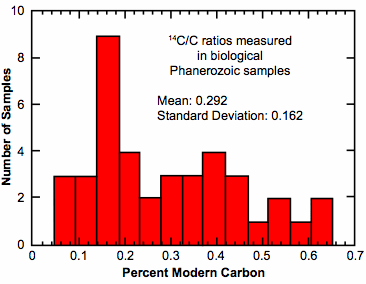
Fig. 7. Distribution of 14C values for biogenic samples from the radiocarbon literature. Given their position in the geological record, all these samples should contain no detectable 14C according to the conventional geological timescale.
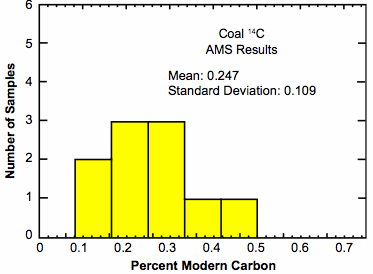
Fig. 8. Histogram representation of AMS 14C analysis of ten coal samples undertaken by the RATE 14C research project.
According to the conventional geologic time-scale, organic materials older than about 250,000 years should be utterly 14C “dead.” This is because the half-life of 14C, only 5,730 years, is so short. 250,000 years of decay (corresponding to 43.6 half-lives) reduces the number of initial 14C atoms by a factor of 7 × 10-14. A gram of modern carbon contains about 6 × 1010 14C atoms, so not a single 14C atom should remain after 250,000 years. The astonishing result, however, is that, almost without exception, when tested by accelerator mass spectrometer (AMS) methods, organic samples from every portion of the Phanerozoic record show detectable and reproducible amounts of 14C! This reality has been established as dozens of AMS laboratories around the world over the last 20 years have sought desperately to understand why organic samples from deep within the geological record, thought to be tens to hundreds of millions of years old, should consistently contain 0.1–0.5% of the modern level of 14C. Believing this 14C had to be contamination, they have mounted an intense quest to identify and eliminate sources of contamination in their AMS procedures. But despite improvements in techniques, this level of 14C, on the order of 0.1–0.5 percent modern carbon (pmc), continues to be reported for samples that, given their location in the geological record, should be entirely 14C “dead.” Many scores of such measurements are readily available in the standard peer-reviewed radiocarbon literature as documented by Giem22 and Baumgardner et al.23 and displayed in Fig. 7. Measurable 14C at roughly uniform values in pre-Flood organic materials fossilized in Flood strata, of course, represents powerful support for the young earth Creation-Flood model.
Aware of this, Snelling24,25,26,27,28 analyzed the 14C content of fossilized wood conventionally regarded as 14C “dead” because it was derived from Tertiary, Mesozoic, and upper Paleozoic strata having conventional ages of 40 to 250 million years. All samples were analyzed using AMS technology by a reputable commercial laboratory, with some duplicate samples also tested by a specialist laboratory in a major research institute. Measurable 14C well above background was obtained in all cases.
More recently, as a check on the AMS results in the peer-reviewed literature, the RATE team acquired a suite of ten coal samples from the U.S. Department of Energy Coal Repository. These samples represent important U.S. coal deposits and span the geological record from Carboniferous to Eocene. The 14C measurements by one of the best AMS laboratories in the world for these ten samples are displayed in graphical form in Fig. 8 and discussed in Baumgardner et al.29 The 14C levels for these samples fall nicely within the range of values shown in Fig. 7. We conclude that the well-documented evidence of 14C in fossil organic material provides compelling support for the young earth Creation-Flood model and represents a severe challenge for the uniformitarian assumptions underlying the long half-life radioisotope methods.
Tentative Conclusions
At this point in the RATE research several tentative conclusions are beginning to emerge, based on the literature searches, theoretical studies, and laboratory findings. Although some are firmer than others, the following conclusions are likely to be in the final report. There will likely also be additional conclusions which are too early to include at this time. The tentative conclusions will only be reported here in outline form. More detail and justifications for most of these conclusions are discussed in the referenced papers in these Proceedings.
- Conventional radioisotope dating methods are unreliable.
- Discordance among different dating methods is common.
- Key assumptions underlying radioisotope dating methods are untenable.
- Mixing of mantle and crustal sources also mixes their isotopic signatures.
- Residual 14C appears to be present in all fossil biogenic material.
- Massive nuclear decay has occurred in rocks.
- Large quantities of daughter elements like Pb, He, and Ar are present.
- Many of the daughter elements are in proximity to the parent elements.
- Fission tracks and radiohalos are numerous.
- Isotopic mixing between the earth’s mantle and crust has occurred.
- Lava flows exhibit isotopic characteristics of the mantle.
- Isotopic data suggest basalts were generated from melting of old mantle.
- Isotopic data also suggest basalt magmas were contaminated during their ascent.
- Residual He and radiohalos suggest recent nuclear decay.
- Large quantities of He are still present in many granites today.
- If He was formed millions of years ago, it should have already escaped.
- Experimentally-determined diffusion rates of He agree with recent production of He.
- Po halos appear to have formed during rapid cooling of granite plutons during the Flood (eliminating millions of years).
- If the cooling of the plutons was rapid, then metamorphism was also rapid during the Flood (eliminating millions of years).
- Massive nuclear decay, radiohalos, helium diffusion, and deep 14C all imply accelerated decay.
- Massive nuclear decay requires higher decay rates before the present.
- Radiohalos formed during the Flood require decay rates higher than observed today.
- Helium diffusion data imply the decay occurred within thousands of years ago.
- Deep 14C implies the decay occurred within thousands of years ago.
- Studies in theoretical physics suggest accelerated nuclear decay can occur.
- Variation in compactified dimensions could affect coupling constants.
- Consequent variation in coupling constants could cause accelerated decay.
- Changes in potential well depth change the α-particle wave function.
- Changes in the α-particle wave function change decay half-lives.
Summary
The basic conclusion of this research is that conventional radioisotopic dating methods are unreliable. The chief reason is that uniformitarianism is not a legitimate model of earth history. Observational evidence supports the recent occurrence of a global catastrophic Flood. Because the earth has suffered a major tectonic catastrophe corresponding to the Genesis Flood, the uniformitarian assumptions that are applied to obtain age estimates from radioisotopic data are simply not true. Intermediate results from RATE support a young-earth, catastrophic, creationist model.
Two remaining years in the research phase will be needed to complete the analysis of samples yet being processed and theoretical studies still being made. By the end of the research phase the final report should be based on a larger data set than was available for this paper. A few research projects within RATE such as Fission Tracks and Biblical Word Studies that have not been discussed in this paper are also expected to contribute to the final report. It is apparent that significant progress has been made in explaining the presence of large quantities of nuclear decay products in a young-earth time frame. The evidence should be stronger and more convincing by the time the research project is completed in 2005. We also hope that by then a more detailed young-earth creationist model of the history of radioactive decay will also have been developed.
Acknowledgments
Appreciation is expressed to the many donors who contributed financially to RATE. Los Alamos National Laboratory provided samples of Jemez granodiorite for chemical and radioisotope analyses and Grand Canyon National Park and Yosemite National Park granted permission to Drs. Austin and Snelling to collect rock samples.
Footnotes
- Vardiman, L. 2000. Introduction. In, Vardiman, L., A. A. Snelling, and E. F. Chaffin (eds.), Radioisotopes and the age of the earth: A young-earth creationist research initiative,pp. 1–25. El Cajon, California: Institute for Creation Research and St. Joseph, Missouri: Creation Research Society.
- Gentry, R. V., G. J. Glish, and E. H. McBay. 1982. Differential helium in zircons: Implications for nuclear waste management. Geophysical Research Letters 9 no. 10:1129–1130.
- Humphreys, D. R. 2000. Accelerated nuclear decay: A viable hypothesis? In, Vardiman, L., A. A. Snelling, and E. F. Chaffin (eds.), Radioisotopes and the age of the earth: A young-earth creationist research initiative, pp. 333–379. El Cajon, California: Institute for Creation Research and St. Joseph, Missouri: Creation Research Society.
- Humphreys, D. R., S. A. Austin, J. R. Baumgardner, and A. A. Snelling. 2003. Helium diffusion rates support accelerated nuclear decay. In, Ivey, R. (ed.), Proceedings of the fifth international conference on creationism, pp. 175–195. Pittsburgh, Pennsylvania: Creation Science Fellowship.
- Chaffin, E. F. 2000. Theoretical mechanisms of accelerated radioactive decay. In, Vardiman, L., A. A. Snelling, and E. F. Chaffin (eds.), Radioisotopes and the age of the earth: A young-earth creationist research initiative, pp. 303–331. El Cajon, California: Institute for Creation Research and St. Joseph, Missouri: Creation Research Society.
- Chaffin, E. F. 2003. Accelerated decay: Theoretical models. In, Ivey, R. (ed.), Proceedings of the fifth international conference on creationism, pp. 3–15. Pittsburgh, Pennsylvania: Creation Science Fellowship.
- Snelling, A. A. 2000a. Radiohalos. In, Vardiman, L., A. A. Snelling, and E. F. Chaffin (eds.), Radioisotopes and the age of the earth: A young-earth creationist research initiative, pp. 381–468. El Cajon, California: Institute for Creation Research and St. Joseph, Missouri: Creation Research Society.
- Snelling, A. A. and M. H. Armitage. 2003. Radiohalos—A tale of three granitic plutons. In, Ivey, R. (ed.), Proceedings of the fifth international conference on creationism, pp. 243–267. Pittsburgh, Pennsylvania: Creation Science Fellowship.
- Snelling, A. A. and J. Woodmorappe. 1998. The cooling of plutons on a young earth. In, Walsh, R. E. (ed.), Proceedings of the fourth international conference on creationism, pp. 527–545. Pittsburgh, Pennsylvania: Creation Science Fellowship.
- Snelling, A. A., S. A. Austin, and W. A. Hoesch. 2003. Radioisotopes in the diabase sill (upper Precambrian) at Bass Rapids, Grand Canyon, Arizona: An application and test of the isochron dating method. In, Ivey, R. (ed.), Proceedings of the fifth international conference on creationism, pp. 269–284. Pittsburgh, Pennsylvania: Creation Science Fellowship.
- Snelling, A. A. 1998. The cause of anomalous potassium-argon “ages” for recent andesite flows at Mt. Ngauruhoe, New Zealand and the implications for potassium-argon “dating.” In, Walsh, R. E. (ed.), Proceedings of the fourth international conference on creationism, pp. 503–525.
- Snelling, A. A. 2000b. Geochemical processes in the mantle and crust. In, Vardiman, L., A. A. Snelling, and E. F. Chaffin (eds.), Radioisotopes and the age of the earth: A young-earth creationist research initiative, pp. 123–304. El Cajon, California: Institute for Creation Research and St. Joseph, Missouri: Creation Research Society.
- Gamble, J. A., C. P. Wood, R. C. Price, I. E. M. Smith, R. B. Stewart, and T. Waight. 1999. A fifty year perspective of magmatic evolution on Ruapehu Volcano, New Zealand: Verification of open system behaviour in an arc volcano. Earth and Planetary Science Letters, 170, 301–314.
- Snelling, A. A. 2003a. The relevance of Rb-Sr, Sm-Nd, and Pb-Pb isotope systematics to elucidation of the genesis and history of recent andesite flows at Mt. Ngauruhoe, New Zealand, and the implications for radioisotope dating. In, Ivey, R. (ed.), Proceedings of the fifth international conference on creationism, pp. 285–303. Pittsburgh, Pennsylvania: Creation Science Fellowship.
- Tatsumi, Y. 1986. Formation of the volcanic front in subduction zones. Geophysical Research Letters 13:717–720.
- Davies, J. H. and D. J. Stevenson. 1992. Physical model of source region of subduction zone volcanics. Journal of Geophysical Research 97:2037–2070.
- Tatsumi, Ref. 15.
- Davies and Stevenson, Ref. 16.
- Tatsumi, Ref. 15.
- Davies and Stephenson, Ref. 16.
- Snelling, A. A. 2003b. Whole-rock K-Ar model and isochron, and Rb-Sr, Sm-Nd, and Pb-Pb isochron, “dating” of the Somerset Dam layered mafic intrusion, Australia. In Ivey, R. (ed.), Proceedings of the fifth international conference on creationism, pp. 305–324. Pittsburgh, Pennsylvania: Creation Science Fellowship.
- Giem, P. 2001. Carbon-14 content of fossil carbon. Origins 51:6–30.
- Baumgardner, J. R., A. A. Snelling, D. R. Humphreys, and S. A. Austin. 2003. Measurable 14C in fossilized organic materials: Confirming the young earth Creation-Flood model. In, Ivey. R. (ed.), Proceedings of the fifth international conference on creationism, pp. 127–142. Pittsburgh, Pennsylvania: Creation Science Fellowship.
- Snelling, A. A. 1997. Radioactive “dating” in conflict! Fossil wood in ancient lava flow yields radiocarbon. Creation Ex Nihilo 20 no. 1:24–27.
- Snelling, A. A. 1998. Stumping old-age dogma: Radiocarbon in an “ancient” fossil tree stump casts doubt on traditional rock/fossil dating. Creation Ex Nihilo 20 no. 4:48–51.
- Snelling, A. A. 1999. Dating dilemma: Fossil wood in ancient sandstone. Creation Ex Nihilo 21 no. 3:39–41.
- Snelling, A. A. 2000c. Geological conflict: Young radiocarbon date for ancient fossil wood challenges fossil dating. Creation Ex Nihilo 22 no. 2:44–47.
- Snelling, A. A. 2000d. Conflicting “ages” of Tertiary basalt and contained fossilized wood, Crinum, Central Queensland, Australia. Creation Ex Nihilo Technical Journal 14 no. 2:99–122.
- Baumgardner et al., Ref. 23.
Recommended Resources

Answers in Genesis is an apologetics ministry, dedicated to helping Christians defend their faith and proclaim the good news of Jesus Christ.
- Customer Service 800.778.3390
- © 2024 Answers in Genesis

